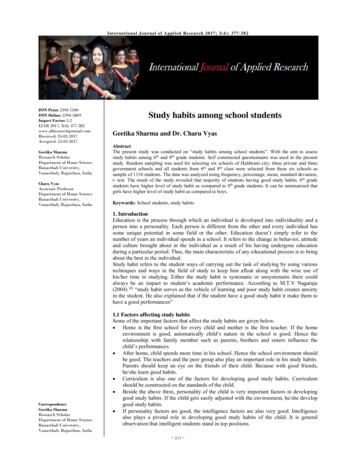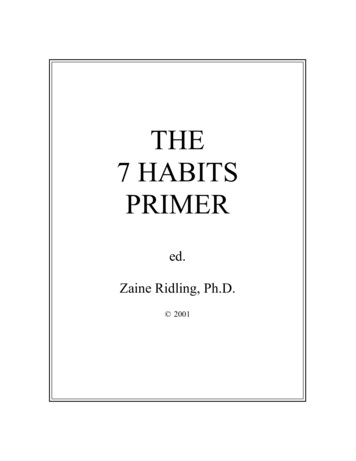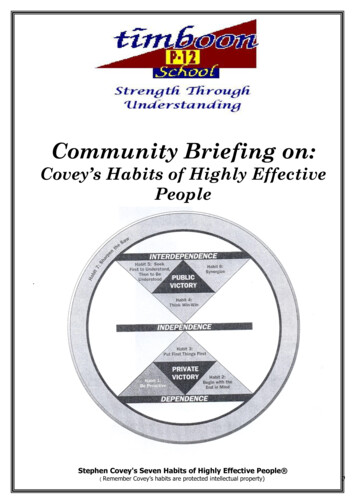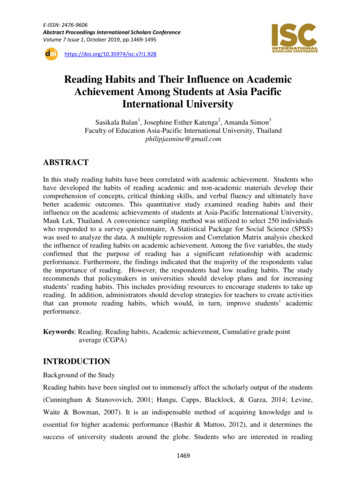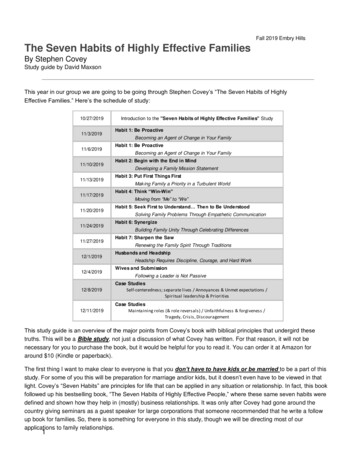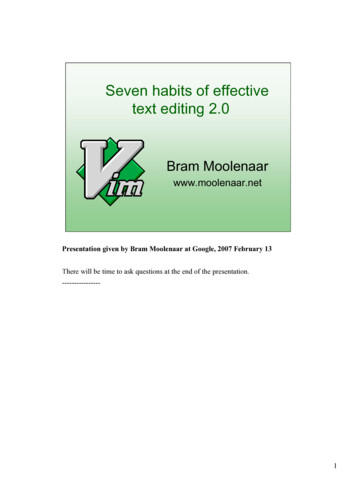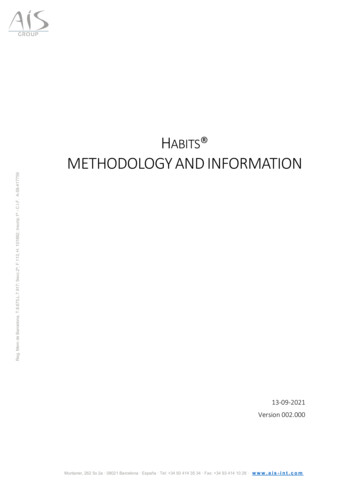
Transcription
Reg. Merc de Barcelona, T.8.675,L.7.917; Secc.2ª, F.113; H. 101882; Inscrip.1ª - C.I.F. A-58-417759HABITS METHODOLOGY AND INFORMATION13-09-2021Version 002.000Muntaner, 262 5o 2a · 08021 Barcelona · España · Tel: 34 93 414 35 34 · Fax: 34 93 414 10 28 · w w w . a i s - i n t . c o m
Version controlVersionDateRevisionGermán Sánchez, MiquelTorrens, Ferran Carrascosa15-01-2015002.00013-09-2021 Germán SánchezInitial versionUpdated to new methodologyand version 2021-1Reg. Merc de Barcelona, T.8.675,L.7.917; Secc.2ª, F.113; H. 101882; Inscrip.1ª - C.I.F. A-58-417759001.000CommentsMuntaner, 262 5o 2a · 08021 Barcelona · España · Tel: 34 93 414 35 34 · Fax: 34 93 414 10 28 · w w w . a i s - i n t . c o m
Overview1. Introducción . 1Reg. Merc de Barcelona, T.8.675,L.7.917; Secc.2ª, F.113; H. 101882; Inscrip.1ª - C.I.F. A-58-4177592. Habits . 12.1.Objectives .12.2.Sources of information.12.3.Definition of Habits Typologies .52.4.Data fusion .64.2.1.Initial state and target . 74.2.2.Definition of family typologies . 74.2.3.Information fusion . 72.5.Habits update .82.6.Census section update .82.7.Cadastre.82.8.Habits 2021-1 T1 .82.9.Information blocks .9Muntaner, 262 5o 2a · 08021 Barcelona · España · Tel: 34 93 414 35 34 · Fax: 34 93 414 10 28 · w w w . a i s - i n t . c o m
1. IntroducciónThe objective of this document, prepared by AIS, is to introduce the methodologyused to generate Habits , as well as to detail the information modules contained in thelatest version of Habits .2. Habits Reg. Merc de Barcelona, T.8.675,L.7.917; Secc.2ª, F.113; H. 101882; Inscrip.1ª - C.I.F. A-58-417759Habits is a set of economic and sociodemographic indicators that provide anaccurate portrait of Spanish society and its way of life. It’s a key tool when definingmarketing and geomarketing strategies.The database is updated every six months, following the updates of the differentsources of information from which it is fed. More specifically, two main updates are madeannually, at the time when the maps and the Municipal Register (Padrón) are updated,on the one hand, and the Family Budget Survey (EPF, from Spanish Encuesta dePresupuestos Familiares), and the Living Conditions Survey (ECV, from Spanish Encuestade Condiciones de Vida) by the other, main sources of information for the Habits generation.2.1. Objectives Habits segments Spanish households into typologies based on theirsociodemographic and economic characteristics, offering a wide range of familyeconomic indicators such as income, expenses, savings, and assets.Habits makes it possible to know the presence and expense profile of each type ofhousehold in each geographical microzone throughout Spain, allowing the precisecalculation of business opportunities in the territory.Habits also makes it possible to assign its information to your own databases forenrichment and segmentation.2.2. Sources of informationAll the information used in the construction of Habits has its origin in public sourcesand Law 15/1999, of December 13, on the Protection of Personal Data is alwaysrespected. The standard information sources used by Habits are the following.1. Population and Housing Census:- Objective: population count and knowledge of its structure.- Variables studied: regarding the population: age, sex, nationality, residence andmarital status, place of birth, migration variables, education, relationship with economicactivity, socioeconomic status, marriage, fertility, kinship relationships, area, size of themunicipality, structure of the homes and family nuclei.Regarding real state: class, area, facilities, useful area in square meters, year ofconstruction, number of rooms, tenure regime and owner class; and by type, number offloors, number of dwellings, class of owner, condition and year of construction of thebuilding.Latest available results: 2011.Diputació, 246 bajos · 08007 Barcelona · España · Tel: 34 93 414 35 34 · Fax: 34 93 414 10 28 · w w w . a i s - i n t . c o m1
Source: INE, Statistics National Institute.Update: decennial.2. Municipal Register (Padrón):- Objective: to provide the official population figures, approved by Royal Decree, ofall Spanish municipalities on January 1 of each year.- Variables studied: population according to different territorial breakdowns byage, sex, origin, and nationality.Latest available results: 2020.Source: INE, Statistics National Institute.Reg. Merc de Barcelona, T.8.675,L.7.917; Secc.2ª, F.113; H. 101882; Inscrip.1ª - C.I.F. A-58-417759Update: annual.3. Household Budget Survey (EPF):- Objective: to provide annual information on the nature and destination ofconsumer spending and on various characteristics related to the living conditions ofhouseholds- Variables studied: total household expenditure, average expenditure perhousehold and average expenditure per person on goods and services in monetary termsaccording to 12 expenditure groups, characteristics of the households and the mainbreadwinner. More than 500 expenditure indicators.Latest available results: 2019.Source: INE, Statistics National Institute.Update: annual.4. Cartography at the census section level:- Objective: to provide information on the polygon into which the Spanish state isdivided, perfectly identifying the different administrative partitions: census section,census district, municipality, province, and Autonomous Community.- Variables studied: cartography of the census sections, including identifiers,names, perimeters, and surfaces.Latest available results: 2020.Source: INE, Statistics National Institute.Update: annual.Diputació, 246 bajos · 08007 Barcelona · España · Tel: 34 93 414 35 34 · Fax: 34 93 414 10 28 · w w w . a i s - i n t . c o m2
5. Survey of life conditions (ECV):- Objective: to provide comparative statistics on income distribution and socialexclusion at the European level- Variables studied: family income, poverty rates, population at risk of socialexclusion.Latest available results: 2019.Source: INE, Statistics National Institute.Update: annual.Reg. Merc de Barcelona, T.8.675,L.7.917; Secc.2ª, F.113; H. 101882; Inscrip.1ª - C.I.F. A-58-4177596. Active Population Survey (EPA), Public Employment Service (SEPE)- Objective: to provide information on the population related to the labour market:employed, active, unemployed, and inactive.- Variables studied: number of employed, active, unemployed, and inactive by ageand sector.Latest available results: first quarter of 2021.Source: INE, Statistics National Institute; SEPE, Public Employment Service.Update: quarterly / annual (respectively).7. Electronic Office of the Cadastre:- Objective: to provide information on all properties in the State (excluding theBasque Country).- Variables studied: counts by type of property, characteristics of the properties(surface area, age, participation coefficient, geolocation.).Latest available results: first half of 2021.Source: Electronic Office of the Cadastre.Update: biannual.8. Real estate portals:- Objective: to obtain information on the portfolio of properties currently for saleand rent.- Variables studied: characteristics of the properties, both residential and nonresidential (flats, houses, shops, offices, garages, storage rooms, industrial ships, land),including the offer price and geolocation; also, for residential properties, counts bynumber of rooms and bathrooms.Latest available results: May 2021.Source: different real estate portals.Update: monthly.Diputació, 246 bajos · 08007 Barcelona · España · Tel: 34 93 414 35 34 · Fax: 34 93 414 10 28 · w w w . a i s - i n t . c o m3
9. Real estate price series:- Objective: to provide information on the real estate market in terms of sale prices,assessment prices, number of transactions, and price indices.- Variables studied: house price indices, number and price of assessments andtransactions for residential and non-residential real estate. Within the residential ones,distinction between free and protected housing, new and not new, etc.Latest available results: 2021.Source: Housing Price Index (IPV, INE), Ministry of Development (Fomento), Notaries.Reg. Merc de Barcelona, T.8.675,L.7.917; Secc.2ª, F.113; H. 101882; Inscrip.1ª - C.I.F. A-58-417759Update: quarterly or monthly.10. Weather information:- Objective: to provide historical meteorological information.- Variables studied: historical data at the municipality level (meteorological station)relative to temperatures, atmospheric pressure, wind, rainfall, sunny days, etc.Latest available results: first trimester of 2020.Source: State Meteorological Agency (AEMet).Update: annual.11. Business activity:- Objective: to provide information on business activity.- Variables studied: natural and legal persons, counts by CNAE, last invoice figureand number of employees, age of the company and debt.Latest available results: 2021.Source: CamerdataUpdate: biannual.12. Criminality:- Objective: to provide information on the volume of crimes broken down by typeof crime.- Variables studied: counts at the municipal level of different types of crimes:homicides, injuries, kidnappings, robberies, drugs.Latest available results: 2020.Source: Statistical portal of crime, Minister for home affairsUpdate: quarterly.Diputació, 246 bajos · 08007 Barcelona · España · Tel: 34 93 414 35 34 · Fax: 34 93 414 10 28 · w w w . a i s - i n t . c o m4
2.3. Definition of Habits TypologiesThe basic typologies are made up of 13 segments or groupings of families dependingon the composition of the household (number of members, number of children andadults) and the ages of its members.The resulting typologies are the following:MatesHouseholds in which more than two adults without children and all of them under65 years of age share a home.SinglesReg. Merc de Barcelona, T.8.675,L.7.917; Secc.2ª, F.113; H. 101882; Inscrip.1ª - C.I.F. A-58-417759Households made up of a single person. According to the age of this person, adistinction is made between a young single (under 35 years old) and an adult single(between 35 and 64 years old).DINKsHouseholds made up of an adult couple without children and both with earnedincome. Depending on the age of the main breadwinner, we distinguish between youngDINKs (under 35 years old) and adult DINKs (between 35 and 64 years old).Full nestHouseholds formed by an adult couple with children. The age of the children makesit possible to differentiate between the following three types: Full nest with youngchildren, where all children are under 16 years old, Full nest with adolescent children,where all children are between 16 and 34 years old, and Full nest with children ofdifferent ages, where children under 16 are mixed with others between 16 and 34 yearsold.Single parentFamilies made up of a single adult with at least one child, all under the age of 25.IntergenerationalFamilies made up of at least three members, one under 25 years old, anotherbetween 25 and 64 years old, and another 65 years old or older.Grandparents at homeFamilies without children consisting of more than two members, where at least oneof them is 65 years or older.SeniorHouseholds made up of one or two adults aged 65 or over and without children. Thenumber of family members defines the typologies One senior or Two seniors.Diputació, 246 bajos · 08007 Barcelona · España · Tel: 34 93 414 35 34 · Fax: 34 93 414 10 28 · w w w . a i s - i n t . c o m5
Reg. Merc de Barcelona, T.8.675,L.7.917; Secc.2ª, F.113; H. 101882; Inscrip.1ª - C.I.F. A-58-417759The following figure shows (in Spanish) a graphic representation of the typologies,generally ordered by the age of the main breadwinner or its members.It is important to note that the typologies are defined sequentially. Thus, if a familyis classified in a certain typology, the following typologies will not be considered even ifthe family also meets its requirements. The order of application of the typologies, whichdefines a priority among them, is as follows:1.2.3.4.5.6.7.8.9.Single parent familiesDINKsTwo seniorsSinglesOne seniorFull nestIntergenerationalMatesGrantparents at home2.4. Data fusionWe have information from the Census and the family budget survey (EPF). However,this information cannot be directly crossed, so it is necessary to carry out a process offusion of the information.For this, AIS has its own algorithm based on Statistical Matching or Data Fusiontechniques. And that consists of combining information from different sources that donot contain common observation units.Subsequently, through the public information available by census section andpopulation units, together with the municipal registers, the information at the censussection level is completed through ecological inference processes.The results by census sections and population units provide the marginaldistributions of the infra-municipal data (census section) and the municipal registersprovide crosses by sex, age, origin, and nationality.Diputació, 246 bajos · 08007 Barcelona · España · Tel: 34 93 414 35 34 · Fax: 34 93 414 10 28 · w w w . a i s - i n t . c o m6
The main steps that are carried out in this phase of data fusion are introduced below.Reg. Merc de Barcelona, T.8.675,L.7.917; Secc.2ª, F.113; H. 101882; Inscrip.1ª - C.I.F. A-58-4177594.2.1. Initial state and targetEach new update of Habits starts from the same initial state: the families included inthe Population and Housing Census are distributed in each of the census sections intowhich the Spanish territory is divided. The general objective of this phase is to perform astatistical matching between the new source to be incorporated (in particular, the EPFand the ECV) and the Census, so that we indirectly impute each record of the survey toeach of the census sections considered.4.2.2. Definition of family typologiesTo carry out this statistical matching between the Census, the EPF and the ECV (orany source of information to be incorporated), the most probable Habits typology isdefined for each family in the Census. Section 2.3 details the set of variables consideredto make this unambiguous definition. On the other hand, the same process is carried outon the families of the source to be incorporated. This step can be carried out in two ways:in case of having the information (social and demographic variables) that defines thetypology in the same way as in the Census (as in the case of the EPF), the same methodis applied to identify the most likely typology for each of the families. On the other hand,if the information included in the new source is not the same as that used to define thetypology, or it is not possible to adapt it, a Machine Learning process is gathered with theCensus data, considering the common variables between the Census and the new source,and this model is applied to the families of the new source, thus obtaining the mostprobable typology for each family of the new source.4.2.3. Information fusionOnce the most probable type of family has been defined for all records in Census andin the source of information to be incorporated into Habits, the propensity scorematching methodology is applied, by means of which a Mahalanobis distance is definedthrough the common variables between Census and the new source (including the Habitstypology). After obtaining this score, each family of the Census is associated with thefamily of the most appropriate source to be incorporated, always respecting thegeographical restrictions (thus making the most of the geographical information availablein both databases) and other types of restrictions linked to the nature of the new datasource to be incorporated.With this methodology we can achieve the initial objective, which was to imputeeach record of the information source to be incorporated into each of the consideredcensus sections. From here, the aggregations of the social, demographic and / oreconomic information provided by the new source of information can be made, towardsthe geographical levels that are considered appropriate (census section, census district,municipality, province, and Autonomous Community).Finally, it should be noted that this methodology ensures that the weighted averageof the different estimates at precise geographical levels coincides with the publisheddata. This is achieved with a calibration phase. In addition, basically three informationvalidation processes are carried out:1.Automatic validation of information, according to its natureFor example, percentage variables must add 1 (or 100), certain variables cannot benegative, and so on.Diputació, 246 bajos · 08007 Barcelona · España · Tel: 34 93 414 35 34 · Fax: 34 93 414 10 28 · w w w . a i s - i n t . c o m7
2.3.Automated expert validationA series of expert thresholds are defined for each variable, so that an alert istriggered if there are values outside of that reasonable range.Manual expert validationVisual validation processes of the geographical distribution of the different estimatedvariables are carried out (through AIS Data Maps ), in addition to analyticalvalidation processes (through AIS Master ).2.5. Habits updateHabits is updated biannually, although some modules may be updated morefrequently.Reg. Merc de Barcelona, T.8.675,L.7.917; Secc.2ª, F.113; H. 101882; Inscrip.1ª - C.I.F. A-58-417759Both the municipal registers and the EPF and the ECV have annual periodicity.However, the Census has a ten-year periodicity and not taking this aspect into accountcould distort the information over time.Reason why, AIS updates the population information contained in its Habits database through weighting processes based on the information contained in themunicipal registers, the EPF and the ECV. Through this update, the information containedin Habits is adjusted considering possible population migrations, possible changes in thedistribution of typologies and its aging / rejuvenation. All this at the census section level.2.6. Census section updateSince the population evolves over time, the definition of the census tracts does too.Every year census sections are born and die and there are also census sections that seethe x y coordinates that determine their borders modified.AIS is aware of this census update process and adjusts the sectioning content inHabits through annual street maps and census polygon maps. Process that is carried outthrough classification processes generated by AIS.2.7. CadastreThe variables included in this block are downloaded every six months and processedfrom the Cadastre registry (the provincial communities are excluded). In general, all thevariables refer to the count of properties with certain characteristics except:- The type of area where it is reported only if the majority of properties are urbanor rural.- Areas, participation coefficients and antiques that are calculated as an average ofthe observed properties.2.8. Habits 2021-1 T1The latest version of Habits published is the one corresponding to the first quarterof 2021 (first semester), whose sources are the following:SourceMaps INEMunicipal registerEPFDate 2020-012020-07-30Update periodicityAnnualAnnualAnnualDiputació, 246 bajos · 08007 Barcelona · España · Tel: 34 93 414 35 34 · Fax: 34 93 414 10 28 · w w w . a i s - i n t . c o m8
Reg. Merc de Barcelona, T.8.675,L.7.917; Secc.2ª, F.113; H. 101882; Inscrip.1ª - C.I.F. A-58-417759ECVEPASEPEINE - IPVMinistry of 2021Q12020-06 a lyThe column "Data date" indicates which period the data obtained from each sourcerefers to, while the column "Publication date" indicates the most recent publication dateof the source.2.9. Information blocksThe different blocks of information contained in Habits are detailed below. Geodemographics: identifiers, names, and density of the differentadministrative partitions.Family typologies: percentage of presence of each of the Habits typologies.Family income.12 Expense groups of the family basket:1. Food and non-alcoholic beverages2. Alcoholic beverages, tobacco, and narcotics3. Clothing and shoes4. Housing, water, electricity, natural gas and other fuels5. Furniture, housing equipment and running costs of housing maintenance6. Healthcare7. Transportation8. Communications9. Leisure, entertainment, and culture10. Education11. Hotels, cafés, and restaurants12. Other goods and servicesProperty Value: purchase and rental real estate prices, absolute and unitaryAVM: valuation of specific properties, offering both asking and closing pricesHousing prices: from INE, Ministry of Development and NotariesEmployment and educational levelMunicipal register: sexes, ages, nationalities, originCadastre, with all the properties of the StateCadastre valuation: valuation of all properties in the Cadastre with our AVMmodelsCensus 2011Diputació, 246 bajos · 08007 Barcelona · España · Tel: 34 93 414 35 34 · Fax: 34 93 414 10 28 · w w w . a i s - i n t . c o m9
Economic Indicators (IE), with economic capacity indicators (ICE) and povertyindicatorsBusiness activityWeatherShopsUse of ICTReg. Merc de Barcelona, T.8.675,L.7.917; Secc.2ª, F.113; H. 101882; Inscrip.1ª - C.I.F. A-58-417759The following figure shows a summary of the modules currently included in Habits :Diputació, 246 bajos · 08007 Barcelona · España · Tel: 34 93 414 35 34 · Fax: 34 93 414 10 28 · w w w . a i s - i n t . c o m10
Sep 13, 2021 · used to generate Habits , as well as to detail the information modules contained in the latest version of Habits . 2. Habits Habits is a set of economic and sociodemographic indicators that provide an accurate portrait of Spanish society and its way of life. It’s a key



